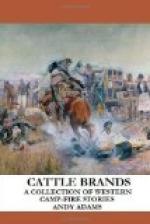The warm sun and green blades of grass suggested springtime. The boys had played the role as long as they cared to. It had served the purpose that was intended. But they must not hurt the feelings of Seigerman, or let the cause of their zeal become known to their benefactor and candidate for sheriff. One day report came in of some defection and a rival candidate in the eastern part of the county. All hands volunteered to go out. Funds were furnished, which the central committee assured their host would be refunded whenever they could get in touch with headquarters, or could see some prominent cowman.
At the end of a week Mr. Seigerman received a letter. The excuses offered at the rich man’s feast were discounted by pressing orders. One had gone to Texas to receive a herd of cattle, instead of a few oxen, one had been summoned to Kansas City, one to Ohio. The letter concluded with the assurance that Mr. Seigerman need have no fear but that he would be the next sheriff.
The same night that the letter was received by mine host, this tale was retold at a cow-camp in the Strip by the trio. The hard winter was over.
At the county convention in May, Seigerman’s name was presented. On each of three ballots he received one lone vote. When the news reached the boys in the Strip, they dubbed this one vote “Seigerman’s Per Cent,” meaning the worst of anything, and that expression became a byword on the range, from Brownsville, Texas, to the Milk River in Montana.
III
“Bad medicine”
The evening before the Cherokee Strip was thrown open for settlement, a number of old timers met in the little town of Hennessey, Oklahoma.
On the next day the Strip would pass from us and our employers, the cowmen. Some of the boys had spent from five to fifteen years on this range. But we realized that we had come to the parting of the ways.
This was not the first time that the government had taken a hand in cattle matters. Some of us in former days had moved cattle at the command of negro soldiers, with wintry winds howling an accompaniment.
The cowman was never a government favorite. If the Indian wards of the nation had a few million acres of idle land, “Let it lie idle,” said the guardian. Some of these civilized tribes maintained a fine system of public schools from the rental of unoccupied lands. Nations, like men, revive the fable of the dog and the ox. But the guardian was supreme—the cowman went. This was not unexpected to most of us. Still, this country was a home to us. It mattered little if our names were on the pay-roll or not, it clothed and fed us.
We were seated around a table in the rear of a saloon talking of the morrow. The place was run by a former cowboy. It therefore became a rendezvous for the craft. Most of us had made up our minds to quit cattle for good and take claims.




